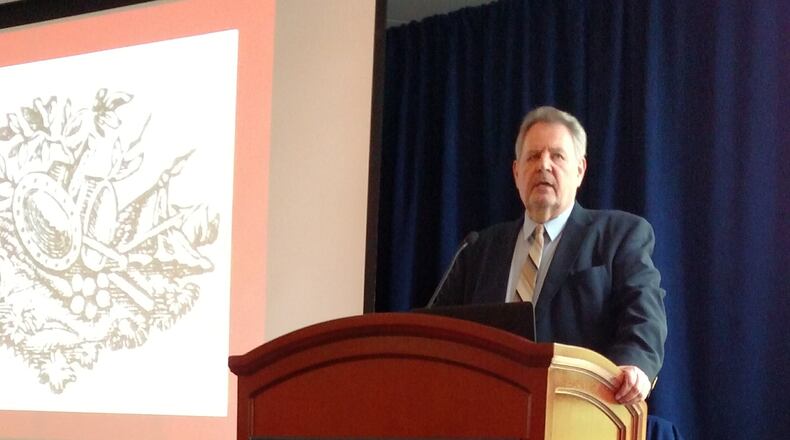An early graduate of the Wright State University public history program, West spent a 30-year career exploring the French and Indian War era as director of the Fort Ligonier museum in Pennsylvania. Since retiring in 2011, he has poured his energy into editing, annotating and fashioning a lengthy introduction to a book freshly released by Kent State University Press.
»MORE STAFFORD: Springfield neighbor remembered for the stories she shared in her sunroom
Originally published in 1765, William Smith’s Bouquet’s Expedition Against the Ohio Indians in 1764 detailed the final and heartrending conclusion of Pontiac’s War, a book read widely in Europe just as books on Iran, Iraq and Syria are read today by Americans keeping up with major events in foreign policy.
An insight on readers’ thoughts during the colonial era is provided by Smith’s reference to a 1597 work by Giovanni Allesandro Valtrini. He cites it to argue that, in his victory, Bouquet had followed the example of the Roman Empire in by adjusting military strategy and tactics to geography and enemy at hand.
West said Bouquet’s well-considered campaign put into the field put an overwhelming force of more than 1,300 in the fall of the year leaves were off the trees (removing an advantage to experienced woodlands fighters) and villages had harvested their winter food stores, the destruction of which would have led to starvation.
»MORE STAFFORD: President Grant’s legacy topic of Springfield Civil War Symposium
What he calls “the first invasion of Europeans into the Ohio country” was forced upon the British by the success Pontiac’s federation had in 1763 capturing nine of 12 British outposts. Significantly, forces of the smaller forts had been thinned by budget cuts the British made after their 1863 defeat of the French. Against Pontiac’s well-coordinated offensive, on Forts Niagara, Detroit and Pitt held.
Just as the colonists would become angered by taxes levied to support the British influence in the New World, West said, the tribes formerly allied with the French were miffed when the British cut their diplomatic budgets and “quit giving the native people presents.”
More important, he said, the tribes “couldn’t get powder, lead and the trade goods” they needed and that had been the most powerful link they had had with the French, whose influence was no more pleasing to them than that of the Brits.
»MORE STAFFORD: Commentary: Springfielders chance meeting in auto repair shop yields spiritual connection
Adding to the tribes’ frustration was the belief that while the British had defeated the French in 1763, they had not defeated the tribes, “which had won most of the engagements they were in,” West said.
The feeling among members of the federation, he said, is that they had not been defeated but rather had been “betrayed in the negotiations that had taken place in Europe” without them even being present. This led to a confidence that they were fully able to control their own destiny.
When the tribal federation fell while facing the specter possible starvation and in the presence of an obviously overwhelming force, tribal insult and injury gave way to heartbreak.
In negotiations near present day Coshocton, West said, the British “demanded the return of every (white) captive taken in the French and Indian War and in Pontiac’s War” - amounting to 278 people seized in raids on the Pennsylvania and Virginia frontiers over years of conflict.
»LOCAL: Northwestern Local wants in “on ground floor” of potential Upper Valley Mall project
“Although some of them were grateful to be released,” West said, others “bitterly resisted” return to “civilization,” including two types of people: Those who remembered no family aside from the one they felt a part of and others “who came to prefer the native way of life.”
“If you were old enough to remember life in the colonies, life (there) was very hard,” he said, particularly for those who had been slaves or indentured servants. This was lost on colonists who “didn’t realize what it meant to have a certain freedom in their lives” that native life offered.
Regardless of the political side people took in the conflict, West said, most sympathized with the anguish of Shawnee and Delaware families that had been torn apart by the departure not only of the original captives but the mixed-blood children who also had to be surrendered under the terms of the peace.
»LOCAL: Snowhill Elementary student among winners in state poster contest
“This is the heart of the war,” West said, and is “what caught the interest in America and later in Europe” about the human cost of the conflict.
West himself has a family connection to the events through distant relative Benjamin West, a Philadelphia-Born artist hired to produce two illustrations for the second edition of Smith’s book, released in 1765. One is of the negotiations for the peace settlement, the other of the heart-rending return of the “captives.”
Martin West chose the latter for the cover of the recently released edition he edited “because it conveyed the essence of the book” and the war’s lasting emotional impression on the world.
West said his own love of history grew out of all the books he checked out from thee Warder Public Library during his youth and the closest of family connections.
»LOCAL: State department directors visit Springfield’s STEM Academy on Ag Day
He happily recalls his feeling of astonishment the day his mother took him up the stairs to the Lois Lenski Children’s Library and, just as he was prepared to see her pay for the books, was told there would be no charge, so long as the books were returned undamaged.
To the now 71-year-old historian, what he then considered “the greatest thing ever” remains a memorable moment of his personal history.
About the Author
